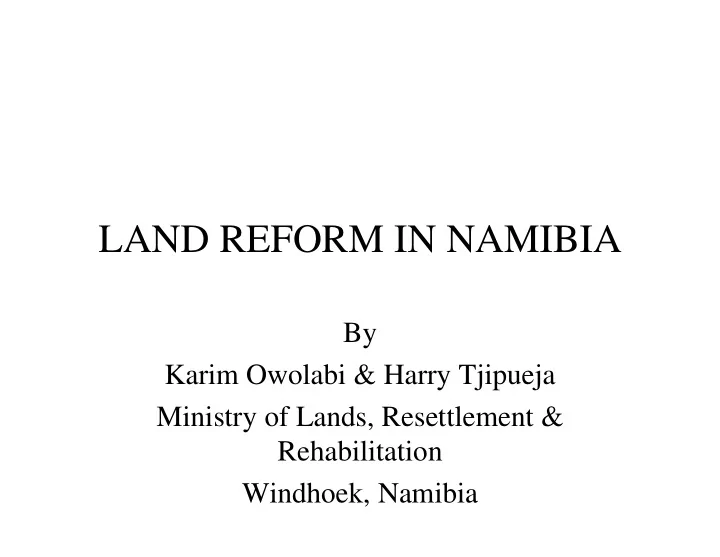

LAND REFORM IN NAMIBIA By Karim Owolabi & Harry Tjipueja Ministry of Lands, Resettlement & Rehabilitation Windhoek, Namibia
CONTENTS • Introduction • A Bit of History • Land Tenure System in Namibia • The Land Question in Namibia • Legal Framework for Land Reform • Process of Land Acquisition • The Role of the Surveyor in Land Reform • Concluding Remarks
INTRODUCTION
* Namibia is a vast country, covering 824,268 km 2 / 82 426 900 ha * total population is approximately 1,8 million people (2001 Census)
A BIT OF HISTORY • 1884 – beginning of formal colonial rule by Germany • 1892 – 8 concession companies acquired rights to virtually all the land utilised by pastoralist communities
. 1897 - the acquisition of land by settlers started in all earnest. . 1902 - By 1902 only 38% of the total land area remained in black hands. . 1904 – Herero war against the Germans due to rapid loss of land . 1906-1907 – Enactment of laws empowering the German colonial authorities to expropriate nearly all land of the Herero and Nama
1945 – Takeover of the colony by the Union of South Africa and the continuation of the policy of establishment of white-owned farms 1952 – process of white-owned farms concluded. Total number of farms = 5214. Tribal homelands established in arid areas . Today , Total Number of Commercial Farms >= 10 000
MAP OF ALL FARMS IN NAMIBIA
Size of Land by Type
Percent Size of Land by Type
Agriculturally Useable Land
Land Tenure System in Namibia •Freehold (rural/commercial farming sector) • freehold (urban) •Customary land tenure (reserves/communal areas) •Leasehold •State land
THE LAND QUESTION IN NAMIBA • At independence, Government was determined to address the imbalances of the past, and was guided by two important principles: the Constitution of the Republic of • Namibia; and ∗ the policy of national reconciliation.
Article 16(1) of the Constitution stipulates All persons shall have the right in any part of Namibia to acquire, own and dispose of all forms of immovable and moveable property individually or in association with others and to bequeath their property to their heirs or legatees… In Article 16(2) provision is made for the expropriation of property in the public interest subject to the payment of just compensation
There are three broad strategies in use to address the land question in Namibia: · redistributive land reform; · the Affirmative Action Loan Scheme; and · the development of unutilized non-title or communal land.
3.1 Redistributive Land Reform First and foremost, a National Conference on Land Reform was convened to address the Land Question in June/July 1991.
Legal Framework for Land Reform • National Land Policy • Agricultural (Commercial) Land Reform Act, 1995 (Act #6 of 1995) • National Land-Use Policy • Land Tax Regulations • Resettlement Policy • Communal Land Act, Etc.
Agricultural (Commercial) Land Reform Act • Purpose of the Act: • To provide for the acquisition of agricultural land by the State for the purposes of land reform and for the allocation of such land to Namibian citizens who do not own or otherwise have the use of any or of adequate agricultural land,….. • LRAC • Policy of willing buyer willing seller • Preferent right to purchase agricultural land • Land Tribunal
Process of Land Acquisition • Offer of sale comes to the Ministry (preferent right) • Assessment by Land Use Planners • Accept or Reject • Valuation by Valuer General • LRAC • Price Negotiation with Farmer • Purchase • Allotment Plans by Land Use Planners • Subdivision Surveys • Lease Agreement Registration –Deeds Office • Etc.
The Role of the Surveyor in Land Reform • Build geo-spatial database of all farms • Build attribute database (Deeds Office) • Link into Cadastral Information System • National Reference Geodetic Framework
Concluding Remarks • 9 million ha of Agric Land would be required for the process (1999) • So far, 113 farms bought so far amounting to 808 784 ha • Willing seller willing buyer strategy not working as desired • There is clamour among the general populace to expropriate farms with just compensation in order to speed up the process
Recommend
More recommend